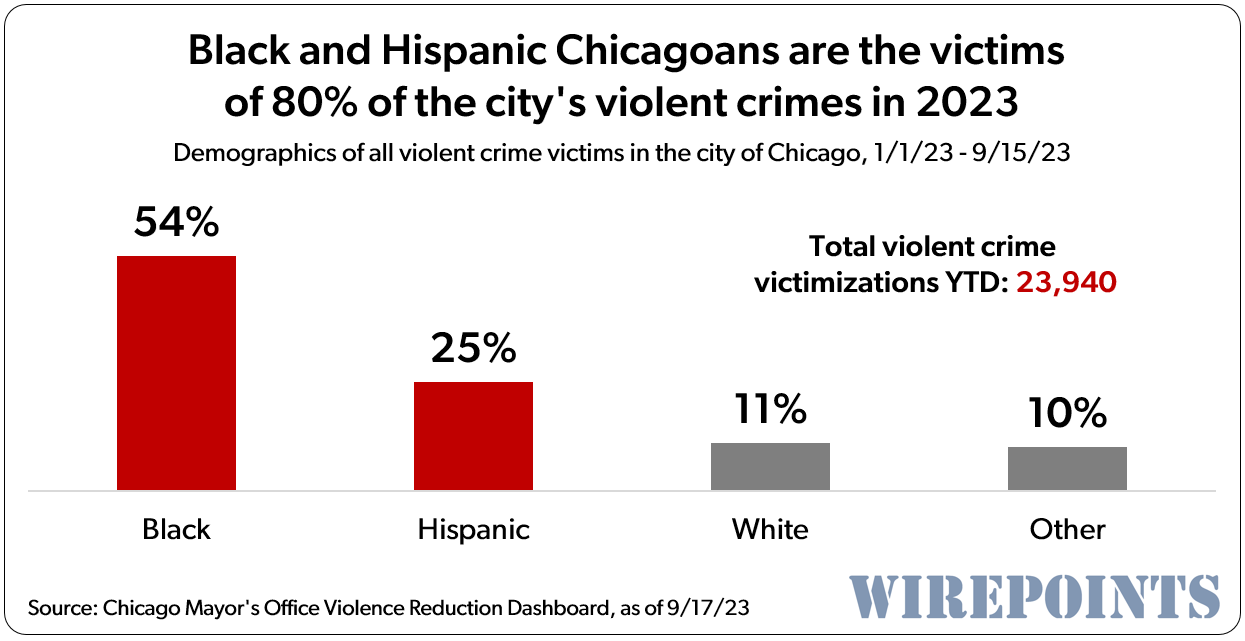Wirepoints notes the Safe-T Act will have a profiund impact on law and order. | Wirepoints
Wirepoints notes the Safe-T Act will have a profiund impact on law and order. | Wirepoints
Illinois’ new “no-cash bail” provision – the most extreme cash bail abolition in the country – goes into effect September 18, continuing Illinois leaders’ long-running move to decriminalize and decarcerate the criminal justice system.
The SAFE-T Act, originally passed in Feb. 2021, increases public safety risks for Illinoisans – Chicagoans, in particular – by increasing the number of criminal defendants on pretrial release. Chicago is already well on its way to hitting a post-2019 high in major crimes, as we reported recently.
The criminal justice system is also likely to end up less equitable than before, despite “equity” being the core justification for bail reforms. The end of cash bail could mean more minority defendants being detained pretrial and even more minorities ending up as victims.
The implementation of the no-cash-bail system is the culmination of more than two years of legislative and judicial conflicts over the SAFE-T Act. The act made major changes to law enforcement regulations and court procedures, but the elimination of cash bail was its most contentious provision. The law was halted for a time, but the Illinois Supreme Court ultimately upheld the law.
The original 2021 law was even more radical than what’s now going into effect, to the point where it had to be amended three times after its initial passage. Prior to the amendments, it was nearly impossible to detain many potentially dangerous felony defendants. The law was changed only after lawmakers faced intense pressure from 100 of Illinois’ 102 county prosecutors.
But though the law is now much better than its original, it still opens the door to more lawlessness in a state already experiencing a crime crisis – of shoplifting, robberies, mob actions, low arrest rates, unanswered 911 calls – and with no plan to deal with it.
Here’s why the SAFE-T should eventually be unwound:
1. More defendants out before trial means more risk to Illinoisans
Under the previous cash bail system, all felonies were potentially detainable by a judge. That is no longer the case under the SAFE-T Act. Defendants accused of many low level “Class 4” felonies, like criminal damage to property, are simply non-detainable now.
More defendants out before trial will, necessarily, increase the risk to ordinary Illinoisans. It’s simple: more defendants on the street equals more potential for crime.
Proponents of the SAFE-T Act will argue they’re simply trying to keep “nonviolent” offenders out of jail before trial, but as the City Journal’s Rafael Mangual argues, “Nonviolent Crime” Is a Myth. “[There’s an] important reality that progressives working to ease up on supposedly nonviolent crimes don’t seem to appreciate: even ‘minor’ offenses like retail theft, open-air drug use, and smoking on subway platforms are frequently backed by a threat of violence.”
In other words, “what progressives seem not to understand is that “minor offenses” are often manifestations of the broadly antisocial dispositions of individuals who likely have a much greater propensity for violence than the law-abiding.”
CWB Chicago has compiled a long list of cases where felony defendants awaiting trial committed additional crimes. In 2022 alone, there were 82 victims of murder and attempted murder by defendants already awaiting trial for a felony in Chicago.
There’s far more evidence than that. The ongoing impact of Cook County’s 2017 bail “reforms” (which resulted in no or low cash bail in the county) offers a glimpse of what the rest of Illinois may face under no-cash bail: a growing number of pretrial defendants out on bond who end up charged with new crimes. As we wrote last year:
Quarterly reports from [Cook County Chief Judge Tim] Evans’ office show that by halfway through 2020 nearly 9,500 defendants released before trial had been charged with new offenses. By mid-2022 that number had grown to 15,086. That was 18 percent of defendants set loose before trial.
Of those 15,000-plus alleged crimes by pretrial defendants freed from late 2017 through mid-2022, 2,841 were classified as violent offenses, or “person offenses” such as battery, assault, or child neglect. Another 1,594 crimes were weapons offenses.
2. Judges have less discretion
The press is saying judges under the safety act will have more discretion than before. That’s not true. Illinois judges now have less discretion. Here’s why.
Before the end of cash bail, Illinois had a three-pronged pre-trial hearing system where a judge could (1) detain a defendant due to a “threat to the community,” (2) release the defendant on his own recognizance, or (3) a middle ground option requiring a defendant to post cash bail.
The middle ground is key. It let a judge release a defendant prior to trial while imposing a financial incentive to ensure good behavior – whether it was the defendant paying or somebody else posting bail. Without cash bail and the control it grants, judges no longer have such middle ground.
But that’s precisely where the new law leaves judges today: just two options: (1) detain or (2) release. Discretion is gone.
3. The loss of bail is a threat to “equity”
The loss of discretion may actually do more harm to “equity” in criminal justice. With cash-bail gone, judges could:
(1) Decide to err on the side of caution and detain “on-the-fence” risky defendants – locking up those who otherwise could have been out on cash bail. That means more minority defendants locked up instead of out on cash bail.
(2) Release potentially violent defendants who, without cash bail, have no financial incentive to behave. And that increases the risk to the general public.
And by general public, we mean minorities. They are the overwhelming victims of crime. Over 95 percent of homicides in Chicago are inflicted on minorities: 80 percent black and 15 percent Hispanic victims.
For overall violent crimes, black and Hispanic minorities are the victims 80 percent of the time.

The SAFE-T is anything but safe
Chicago has led the nation in homicides for 11 years running. We’ve recently reported that 60 percent of urgent 911 calls in 2022 had no police to respond. Arrest rates for major crimes have fallen to a pathetic 5 percent.
And yet, there’s no plan to address the crisis. Instead, Gov. J.B. Pritzker, Chicago Mayor Johnson, Cook County State’s Attorney Kim Fox and Cook County Chief Judge Tim Evans have all decided to pursue decriminalization and decarceration. The SAFE-T Act is a key part of that agenda.





 Alerts Sign-up
Alerts Sign-up